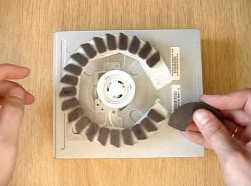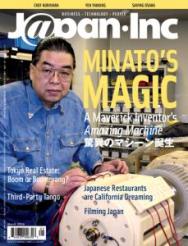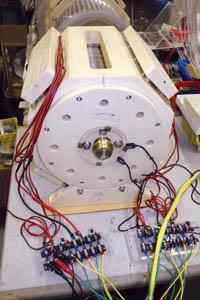Categories: Controversial issues, Interesting electrical news
Number of views: 104949
Comments on the article: 15
Minato's magnetic motor: is there a cornucopia of magnetic energy?
Using the Minato engine and similar structures as an example, the possibility of using magnetic field energy and the difficulties associated with its practical application are considered.
 In our daily lives, we rarely notice the field form of the existence of matter. Unless, when we fall. Then the gravitational field becomes a painful reality for us. But there is one exception - field of permanent magnets. Almost everyone in childhood played with them, panting to break two magnets. Or, with the same excitement, move the stubbornly opposing poles of the same name.
In our daily lives, we rarely notice the field form of the existence of matter. Unless, when we fall. Then the gravitational field becomes a painful reality for us. But there is one exception - field of permanent magnets. Almost everyone in childhood played with them, panting to break two magnets. Or, with the same excitement, move the stubbornly opposing poles of the same name.
With age, interest in this occupation disappeared, or, conversely, became the subject of serious research. Idea practical use of the magnetic field appeared long before the theories of modern physics. And the main thing in this idea was the desire to use the “eternal” magnetization of materials to obtain useful work or “free” electrical energy.
Inventive attempts at the practical use of a constant magnetic field in engines or electric generators do not stop today. The appearance of modern rare-earth magnets with a high coercive force has fueled interest in such developments.
 An abundance of witty designs of varying degrees of efficiency flooded the information space of the network. Among them stands out mover of Japanese inventor Kohei Minato.
An abundance of witty designs of varying degrees of efficiency flooded the information space of the network. Among them stands out mover of Japanese inventor Kohei Minato.
Minato himself is a musician by profession, but has been developing for many years magnetic motor own design, invented, according to him, during a concert of piano music. It's hard to say what kind of musician Minato was, but he turned out to be a good businessman: he has patented his engine in 46 countries and continues this process today.
It should be noted that modern inventors behave rather inconsistently. Dreaming of making mankind happy with their inventions and staying in history, they try with equal diligence to hide the details of their developments, hoping in the future to receive dividends from the sale of their ideas. But worth remembering Nikola Teslawhen he, in order to promote his three-phase motors, refused patent deductions from the company that mastered their release.
Back to Minato's magnetic motor. Among many other similar designs, his product stands out for its very high efficiency. Without going into details of the design of the magnetic motor, which are still hidden in the patent descriptions, it is necessary to note several of its features.
 In its magnetic motor, sets of permanent magnets are located on the rotor at certain angles to the axis of rotation. The passage of the “dead” point by magnets, which, according to Minato's terminology, is called the “collapse” point, is ensured by supplying a short powerful pulse to the stator's electromagnetic coil.
In its magnetic motor, sets of permanent magnets are located on the rotor at certain angles to the axis of rotation. The passage of the “dead” point by magnets, which, according to Minato's terminology, is called the “collapse” point, is ensured by supplying a short powerful pulse to the stator's electromagnetic coil.
It is this feature that ensured Minato's design high efficiency and quiet operation at high speeds. But the assertion that the engine's efficiency exceeds unity does not have any basis.
To analyze Minato’s magnetic motor and similar structures, consider the concept of “latent” energy. Latent energy is inherent in all types of fuel: for coal it is 33 J / gram; for oil - 44 J / gram. But the energy of nuclear fuel is estimated at 43 billion of these units. According to various, conflicting estimates, the latent energy of the permanent magnet field is about 30% of the potential of nuclear fuel, i.e. It is one of the most energy-intensive sources of energy.
But using this energy is far from easy.If oil and gas, when ignited, immediately gives up all its energy potential, then with a magnetic field, everything is not so simple. The energy stored in a permanent magnet can do useful work, but the design of the propulsors is very complex. An analogue of a magnet can be a battery of very large capacity with no less large internal resistance.
Therefore, several problems immediately arise: it is difficult to obtain large power on the motor shaft with its small dimensions and mass. A magnetic motor will lose its power over time as it consumes stored energy. Even the assumption that energy is being replenished Earth's magnetic fieldcannot fix this flaw.
The main drawback is the requirement for precision assembly of the engine design, which prevents its mass development. Minato has so far been working to determine the optimal arrangement of permanent magnets.
Therefore, his grievances against Japanese corporations that do not want to master the invention are unfounded. When choosing an engine, any engineer, first of all, will be interested in its load characteristics, power degradation during the service life, and a number of characteristics. Similar information on Minato engines, as well as the rest of the designs, is still missing.
Rare examples of the practical embodiment of magnetic motors raise more questions than admiration. Recently, SEG from Switzerland announced its readiness to produce compact generators for order, in which a variety Searl magnetic motor.
The generator generates a power of about 15 kW, has dimensions of 46x61x12cm and a service life of up to 60 MW-hours. This corresponds to an average life of 4,000 hours. But what will be the characteristics at the end of this period?
The company honestly warns that after this it is necessary to re-magnetize the permanent magnets. What is behind this procedure is unclear, but most likely, this is a complete disassembly and replacement of magnets in a magnetic motor. And the price of such a generator is more than 8500 euros.
Minato also announced a contract for the manufacture of 40,000 fans with magnetic motors. But all these examples of practical application are single. Moreover, no one claims at the same time that their devices have an efficiency of more than one, and they will work “forever”.
If the traditional induction motor is made of modern expensive materials, for example, silver windings, and the magnetic circuit is made of thin steel amorphous tape (glass metal), then at a price comparable to a magnetic motor we get a close efficiency. At the same time, induction motors will have a significantly longer service life with ease of manufacture.
Summing up, it can be argued that so far no successful designs of magnetic motors suitable for mass industrial development have been created. Those samples that are workable require engineering refinement, expensive materials, precision, individual customization and cannot compete with already mastered engine types. And the allegations that these engines can work for an unlimited time without supplying energy are completely groundless.
See also:How to make a perpetual motion machine with your own hands
See also at electro-en.tomathouse.com
:
